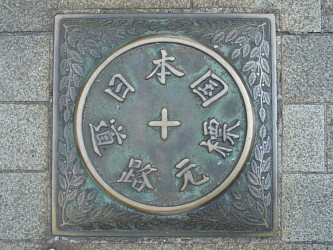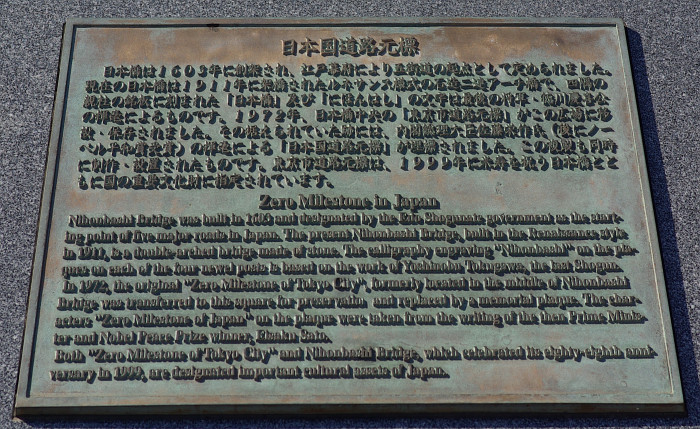日本国道元標
日本橋は1603年に創架され、江戸幕府により五街道の起点として定められました。
現在の日本橋は1911年に架橋されたルネサンス様式の石造り二連アーチ橋で、四隅の親柱の銘板に刻まれた「日本橋」及び「にほんはし」の文字は最後の将軍・徳川慶喜公の揮毫によるものです。1972年、日本橋中央の「東京市道路元標」がこの広場に移設・保存されました。その据えられていた跡には、内閣総理大事に佐藤栄作氏(後にノーベル平和賞受賞)の揮毫による「日本国道路元標」が埋標されました。この複製も同時に制作・設置されたものです。東京市道路元標は、1999年に米寿を祝う日本橋とともに国の重要文化財に指定されています。
Zero Milestone in Japan
Nihonbashi Bridge was built in 1603 and designated by the Edo Shogunate government as the starting point of five major roads in Japan. The present Nihonbashi Bridge, built in the Renaissanee style in 1911, is a double-arched bridge made of stone. The calligraphy engraving "Nihonbashi" on the plaques on each of the four newel posts is based on the work of Yoshinobu Tokugawa, the last Shogun. In 1972, the original "Zero Milestone of Tokyo City", formerly located in the middle of Nihonbashi Bridge was transferred to this square for preservation and replaced by a memorial plaque. The characters "Zero Milestone of Japan" on the plaque were taken from the writing of the then Prime Minister and Nobel Peace Prize winner, Eisaku Sato.
Both "Zero Milestone of Tokyo City" and Nihonbashi Bridge, which celebrated its eighty-eighth anniversary in 1999, are designated important cultural assets of Japan. |

